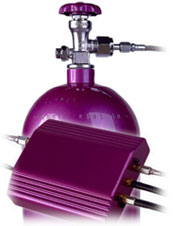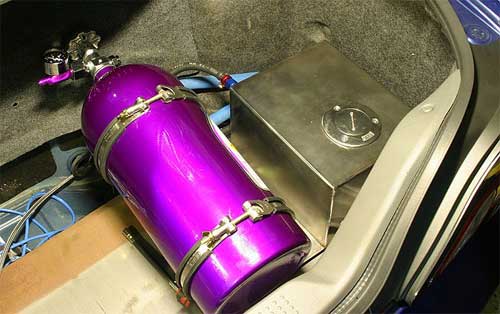 NITROUS OXIDE SYSTEM
NITROUS OXIDE SYSTEM
When it comes to souping up cars, even laymen usually have two words in their heads – turbo and NOS. NOS, or its proper name nitrous oxide. Sounds cool doesnt it?
Contrary to popular believe, NOS isnt the chemical acronym for nitrous oxide. It is actually the acronym for Nitrous Oxide Systems, the largest manufacturer of automotive nitrous oxide injection systems out there. Its become so synonymous with the gas, like how Maggi is associated with instant noodles, Colgate is associated with toothpaste, or Nescafe with instant coffee, or how making a photocopy of something is called Xerox-ing. Nitrous oxides chemical designator is actually N2O, because it has 2 nitrogen atoms and 1 oxygen atom.
Lets find out more about nitrous oxide injection systems.
What is Nitrous Oxide?
The usage of Nitrous Oxide to enhance engine performance dates way back to World War II where N2O was used in fighter planes to compensate for less oxygen in the atmosphere at high altitudes. One of the first uses of nitrous oxide in cars was by NASCAR racer Smokey Yunick who used nitrous oxide in his car to win races until it was discovered and banned by NASCAR.
Nitrous oxide is color-less and non-flammable. Apparently it smells somewhat sweet. Dentists use nitrous oxide to as anesthetic for patients, and its known as laughing gas in the dentistry circles. Its stored in the vehicle in liquid form in a canister. Because of limited storage capacity, usually limited “shots†of nitrous oxide is stored and the driver uses it sparingly in bursts by activating a button. Like what you see in The Fast and the Furious.
How does Nitrous Oxide work?
So how exactly does injecting nitrous oxide into the engine help? Combustion is basically igniting a mixture of oxygen and fuel in a combustion chamber with a sparkplug. The resulting explosion produces power. What happens is a nitrous oxide injection system pumps nitrous oxide into an engines intake system. At 296 degrees Celsius, the nitrous oxide breaks down into nitrogen and oxygen. The loose oxygen atom is burned together with the combustion. More oxygen = more power. Its as simple as that.
Of course there are some issues with the proportion of fuel and air and pre-mature detonation that well look at later. Also, why not just inject oxygen instead of nitrous oxide since what we need is the oxygen anyway? Pure oxygen would result in too wild a combustion, resulting in a blown engine. This is because the nitrogen atoms in the nitrous oxide have a function as well. The nitrogen atoms released have a cooling effect on the combustion temperature. It absorbs the heat and helps carry it away.
Nitrous oxide also cools the intake temperature by 60 to 75 degrees Fahrenheit and every 10 degrees Fahrenheit reduction in temperature gives you about 1% horsepower gains. So on top of the extra power provided by the extra oxygen, you get another 6-7% horsepower gains from the cooling effect. In one of the Sepang Drag Battle rounds, the winning Proton Satria used nitrous oxide to cool the intake air instead of an intercooler. That way, you save weight and reduce the lag that you get when you have to pass turbocharged air through the passages inside an intercooler.

Nitrous oxide storage tank in a car boot
Those who are more familiar with nitrous oxide would have heard the terms dry kit and wet kit. What is the difference between nitrous oxide dry injection and nitrous oxide wet injection kits?
Nitrous Oxide Dry Injection Kits
Nitrous oxide dry injection kits spray nitrous oxide into the intake manifold and it is mixed with fuel and air at the injectors. Dry shots of nitrous oxide usually provide less of a power increase because there is no way of providing additional fuel to balance the extra oxygen in the combustion mixture. So you have to be a little conservative as too lean of an air-fuel mixture will cause the engine to just blow up. At least with stock factory injectors anyway.
Nitrous Oxide Wet Injection Kits
The other type of nitrous oxide injection is wet nitrous oxide injection. Wet nitrous oxide shots have fuel in them. This explains the usage of the word wet. The nitrous oxide is mixed together with fuel and a fogger injects this mixture directly into the throttle body. This provides the extra fuel to balance out the extra oxygen provided by the nitrous oxide, thus keeping the air-fuel mixture stoichiometric or not too lean. However wet nitrous injection kits might cause puddles of fuel to be stuck in the intake manifold, and cause severe backfire conditions.
There is also a hardcore form of wet nitrous shots called direct-port injection. In this system, each cylinder gets its own nitrous injector. For this modification, the whole intake manifold has to be removed and fitted with a custom one.
Is Nitrous Oxide Safe?
With the increased power being created, how does one control the process so that no engine blown cases will happen? Using wet nitrous shot kits is one way, as it mixes the additional fuel necessary to keep the air-fuel mixture balanced. Ignition controllers are also sometimes installed to retard the spark timing when nitrous oxide is being used, to prevent premature detonation, also known as knocking or pinging. Higher octane fuel should also be used.
Balancing the air-fuel mixture with the extra oxygen provided by nitrous oxide is also a tricky thing. Too lean and youll get detonation problems which will damage the engine. Too rich and youll lose power. But its all fun, tuning your car to the maximum performance. Good learning process.
To end this post on nitrous oxide, let’s have a look at how nitrous oxide can breath new life (and power) into your engine! Enjoy this video clip by Top Gear, where they kit up an old Jaguar with nitrous oxide and pitch it against some newer supercars.



0 comments:
Catat Ulasan